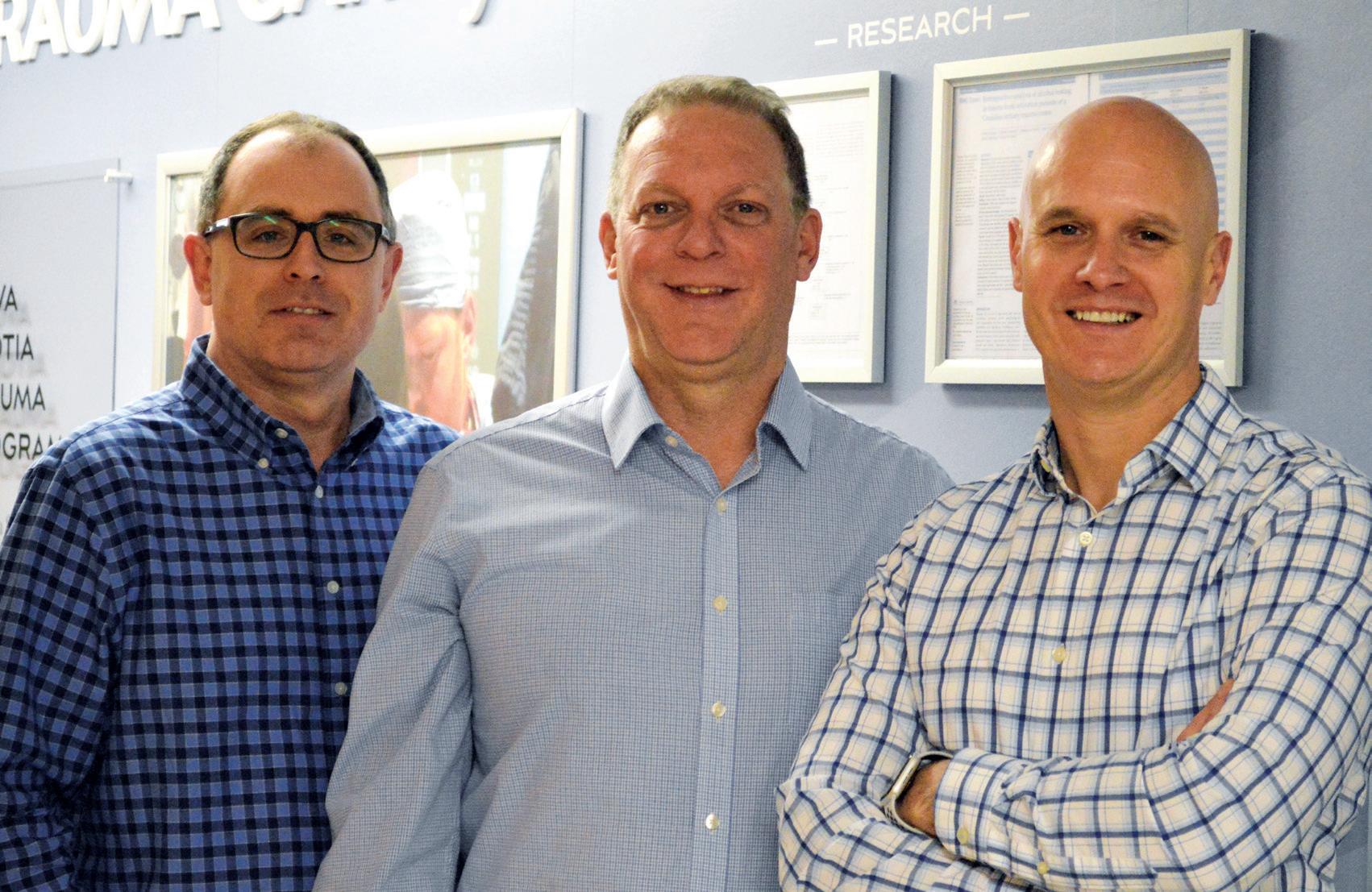
8 minute read
Supportive care
By Erin Elaine Casey
Terra Thibault, health services manager for Ambulatory Oncology Clinics in the Cancer Centre at the QEII Health Sciences Centre, is one of the driving forces behind the QEII’s Supportive Care Clinic (SCC), where patients going through radiation therapy can receive timely and personalized treatment for side-effects.
Advertisement
Certified oncology nurse Charlene Rodrigues is one of two nurses who run the SCC, the only nurse-led clinic of its kind in Canada.
“When patients have ongoing radiation treatment, they can have side-effects like skin problems, dehydration and pain,” Charlene explains. “The nurses who work here have always known that there was a need for this clinic and that need has now been recognized.”
Before, patients experiencing side-effects could be seen at the cancer centre, but there was no specialized clinic. “If we can support them, we can decrease hospital admissions and emergency department visits,” says Terra. “From a nursing perspective, you feel like you can take that extra time to take care of that patient. It’s the right care at the right time.”
The SCC opened in September 2018 as a pilot project running three or four days a week in a borrowed space. Today, the clinic is permanent and has two dedicated nurses and a dedicated physician on call five days a week. Patients are assigned to one nurse and there’s a phone line where they can leave messages.
From the time it opened to the end of November 2019, the SCC has carried out 1,424 supportive care activities, including rehydration, dressing changes, IV line and feeding tube care and pain management.
As the largest specialized cancer care centre for Atlantic Canadians, the QEII delivers world-class care to address some of Canada’s highest cancer rates. “The challenge we face is patients having to travel up to hundreds of kilometres for care, which is really different than if you live in Toronto,” explains Dr. Jean-Philippe Pignol, head of the Department of Radiation Oncology and a professor at Dalhousie University.
Patients typically require a few weeks of daily radiation treatment and can experience side-effects for several weeks after finishing. “These side-effects can be very scary for everyone, including the local doctor.”
Dr. Pignol and his team knew they needed radiation oncology custom-made for Nova Scotians. “We focus on a one-stop shop,” he says.
That includes the SCC and the newly established Rapid Response Clinic. Another pilot project currently running one day a week, the Rapid Response Clinic provides urgent care for patients who need immediate relief from symptoms like pain. “Within four hours, they’ve been seen, received their radiation treatment and developed a pain management plan with their nurse,” adds Terra. “And some people are coming from Yarmouth, for example. So, a process that used to take all day and be very hard on Yvonne Pettipas (left) and Charlene Rodrigues (right), registered nurses, run the QEII’s Supportive Care Clinic, the only nurse-led clinic of its kind in Canada. This clinic allows patients going through radiation therapy access to timely and personalized treatment for side-effects, such as dehydration, skin problems and pain. QEII Foundation
the patient is much easier now.”
The clinic has also had a positive impact on patients who previously needed to stay in hospital to manage their symptoms.
“Hospital admissions are reduced by almost 30 per cent,” says Dr. Pignol.
Charlene, along with Yvonne Pettipas, the clinic’s other dedicated nurse, recently presented at the annual Canadian Association of Nurses in Oncology conference in Winnipeg.
“It was standing room only,” says Charlene. “We’re patientfocused and patient-centred. As front-line nurses in supportive care, we feel so empowered to make decisions and carry out interventions to help patients right away.”
Everyone agrees making the SCC a reality was a team effort,
Hospital admissions are reduced by almost 30 per cent. — Dr. Jean-Philippe Pignol from the highest levels of leadership, including health services director for the cancer care program Jill Flinn and every member of the cancer centre staff. Dr. Pignol gives a great deal of credit to Terra and the nursing team.
“What they’ve developed is quite unique,” says Dr. Pignol. “The Supportive Care Clinic is a smart and inexpensive idea with a huge return.”
At the end of the day, it’s the patients who reap the greatest rewards of this high standard of care. For Charlene, that means patients feel seen.
“This is what we do and what we love doing,” she says. “We’re validating their questions and validating their experience: You’re important and your challenges are important.”
HELPING IS IN OUR NATURE.

By Allison Lawlor
Thousands of Nova Scotians experience traumatic injuries every year, from falls and motor vehicle collisions, to stabbings and gunshot wounds.
The dedicated team at Trauma Nova Scotia works hard to continuously improve and ensure consistencies in the quality of care people receive throughout the province. Based at the QEII Health Sciences Centre, the team also offers ongoing professional education, conducts research and finds effective ways to reduce the burden of trauma — on both patients and the healthcare system. “Our program has a provincial scope with a goal of providing the best patient care possible, no matter where an injury occurs,” says Dr. Robert Green, the medical director of Trauma Nova Scotia. Established in 1997, Trauma Nova Scotia takes a provincial approach to reducing the impact of traumatic injuries for Nova Scotians. In 2018, the program was formally integrated with Nova Scotia Health Authority’s Trauma Program, creating greater opportunity for collaboration throughout the province.
“Through this collaboration, we are continuously evolving to provide the best possible patient care and outcomes,” says Lewis Bedford, NSHA’s provincial director for trauma and urgent care. Reducing the number of traumatic injuries and improving patient outcomes is essential. Trauma is the leading cause of death for Nova Scotians under the age of 45 — and the number of trauma-related incidences in the province is growing. Between 2008 and 2018, these types of injuries increased by more than six per cent.
Across the province, the team is working with clinicians in places like Yarmouth and Cape Breton to advance trauma care. The IWK Health Centre, for pediatric care, and Emergency Health Services are key partners in providing comprehensive, integrated trauma care, including pre-hospital care.
“It’s important for us to work together, across organizations and the province, to best facilitate care for patients,” says Dr. Green. “Having a collaborative trauma system is what saves lives.”
Part of this collaboration is the healthcare teams beyond the trauma room. Depending on the traumatic injury, a patient may need immediate surgery or be admitted to an ICU. As their condition improves, they often spend weeks as an inpatient before moving on to the QEII’s Rehabilitation and Arthritis Centre to regain strength and mobility or even relearn daily life activities. Some may need followup care for years to come. “Working with our partners throughout the healthcare system ensures optimal quality of patient care throughout their journey,” says Lewis.
Since its inception more than two decades ago, Trauma Nova Scotia has developed and evolved the province’s trauma system through some of its core functions, such as maintaining the Trauma Registry, education and research. “We really believe in using our data to inform practice,” says Dr. Green.
Nova Scotia is one of the Lewis Bedford (left), provincial director, urgent and trauma care; Rob MacKinley (centre), health services manager, trauma and emergency programs; and Dr. Rob Green (right), medical director, Trauma Nova Scotia, work with their dedicated teams to continuously evolve practice and provide the best possible patient care and outcomes. QEII Foundation

country’s only provinces to have a population-based trauma database that captures information on major traumas from hospitals across the province. With 14,000 patients, the registry helps monitor and ensure the quality of the trauma system and provides data for research that informs trauma-related policies and clinical practice.
Using data from the registry, Dr. Green and his team can also recognize challenges, develop solutions and change practice. Through the data, they monitor critical events like the time between a patient’s arrival at the hospital and when they undergo a CT scan. Now, a trauma patient will receive a CT scan within 25 minutes of arriving at the QEII. “The shorter that time is, the better the patient’s outcome,”
says Dr. Green.
Education is another big part of what Trauma Nova Scotia does well. As many as 10 times a year, Dr. Green and his team teach a hands-on course to physicians, nurses and paramedics, mostly within their home towns across Nova Scotia. Using clinical-grade cadavers — one of the only organizations in North America to do so — they teach how to assess a patient’s condition, resuscitate, stabilize and arrange inter-facility transfers in the trauma system. “We educate hundreds of people over the course of a year across the province,” says Dr. Green.
On Trauma Nova Scotia’s website, healthcare professionals can find information on a range of educational programs and watch instructional videos on
procedures such as basic airway management and inserting a chest tube. New videos are continuously added with the goal of improving patient care. “It’s a way clinicians across the province can keep updated on the latest procedures,” Dr. Green says.
In March 2020, the Trauma Association of Canada will hold its annual conference in Halifax. This will be the second time in four years that national and international clinicians and trauma system leaders have gathered in our province to share leading practices in trauma care and research.
For more information about trauma care in Nova Scotia, visit trauma-ns.com.






